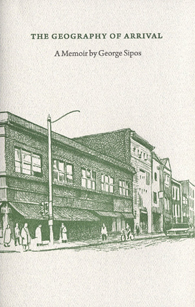Reviews
Nonfiction Review by Karen Schindler
George Sipos, The Geography of Arrival: A Memoir (Kentville: Gaspereau, 2010). Paperbound, 152pp., $25.95.
When I took up George Sipos’s memoir, I had recently been led to the work of French essayist Frances Ponge, known for using meticulous description (devoting several pages, for example, to the investigation of a raindrop or a pebble) in order to think more clearly about human experience. This method of exploring complex ideas within the context of everyday objects provided a provocative backdrop for Sipos’s book—a series of essays in which the author revisits London, Ontario, where his family settled after emigrating from Hungary in 1957. The Geography of Arrival spans ten years of Sipos’s youth before his family relocated to British Columbia. Each chapter is set at either a London landmark (St. Peter’s Basilica, Victoria Park, the Western Fairground), or a more personal tract of Sipos’s geography (a neighbour’s cedar shaded porch, a favourite Dundas Street diner). Though situated in 1960s London, this memoir easily transcends local interest. Using place as a point of departure—a method his title interestingly inverts—Sipos typically focuses on the things that occupy these spaces. While his methods are less rigorous than those of Ponge, his attentiveness creates a similar trajectory that radiates away from the given object or situation.
The chapter “Rocket” opens on an undeveloped downtown field, shifts its emphasis to the red rocket that Sipos repeatedly attempts to launch from the meadow’s centre, and ends with a meditation on the possibilities we attempt to attach to things (and perhaps memories as well):
When it fell back to the ground it just lay there—intact for sure, but also unscarred. I don’t know what I expected, but I longed to see it pockmarked by a journey among stars … luminous, if possible, with the afterglow of galaxies. Instead it was merely a thing of earth returned to earth.
Sipos’s method is delicate. He moves from place to object to contemplation, drawing unexpected connections and converging candid coming-of-age recollections with careful perceptions. “Dipping Bird” describes a teacher-organized excursion to the apartment of one of Canada’s first female physicists. After characterizing the uncertain effect of the retired scientist on the teenagers (Sipos is more interested in the body geometry of a classmate as she leans on a sofa across the room than in the physicist’s explanation of radiation), he segues to the description of a toy sitting on the windowsill—the familiar bobbing glass bird, repeatedly dipping its beak into a glass of water. Sipos’s deceivingly casual synopsis of the science—“the secret is…a point of balance whose fate it is to be repeatedly lost, and through loss regained”—manages to sum up not only the academic principles, but also the turbulent situation of the teenagers themselves.
The prevailing metaphor of the memoir—the unearthing of personal artefact—is nicely set up in “Archaeology,” where Sipos recalls his reaction to a newspaper article about a summer student who, while digging in the basement of London’s oldest historic residence, uncovers a previously unknown foundation: “I was very taken by this discovery. I didn’t mind that it was not a skeleton they had found…. The find was only a stone wall, but it had remained hidden all those years.” This excavation is echoed in events occurring in his family’s first Canadian apartment—the puzzling appearance of a plastic hockey player in a box of cornflakes, the repeated emergence of a chrome Indian chief on a snow-covered Pontiac in the courtyard. Sipos’s confession that “the mystery lay not in not knowing what the removal of snow would uncover, but in the archaeological act itself” is a key to this collection, and part of a sub-commentary on the elusive nature of memory threaded throughout. In “Rabbit,” the description of a reversed déjà vu experience in a local ornamental garden makes reference to Marcel Proust’s famous “episode of the madeleine.” The passage supports Proust’s suggestion that involuntary memories, triggered by unexpected stimulants, come closest to capturing the essence of the past. But at the same time, Sipos seems to challenge Stephen Hawking’s question, “Why do we remember the past and not the future?”
The garden epitomized for me the concept of classical elegance… at a time when I had no idea what “the classical” as a historic aesthetic might mean. But I know that years later when I visited the Boboli Gardens in Florence I immediately recognized everything…as if the fragrance of box in that London park, the formalism of water pouring from stone had been a remembrance of something I would experience only years later, not as a premonition, recognized as such in hindsight, but a genuine remembrance, like the dunking of a madeleine into coffee.
Sipos’s poetry (his second collection, The Glassblowers, was published by Goose Lane in 2010) is known for its meditative lyricism, and his non-fiction similarly shows an ear for the music of language. Like good poetry, this memoir goes beyond personal biography, addressing how the internal ideas that come to define us are formed, and the ways we attempt to balance the tenacious nature of memory against its unreliable geography.
—Karen Schindler









